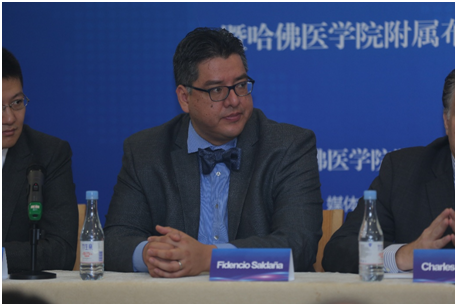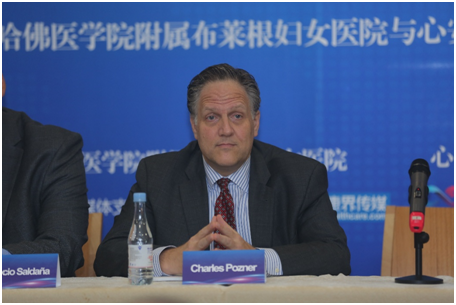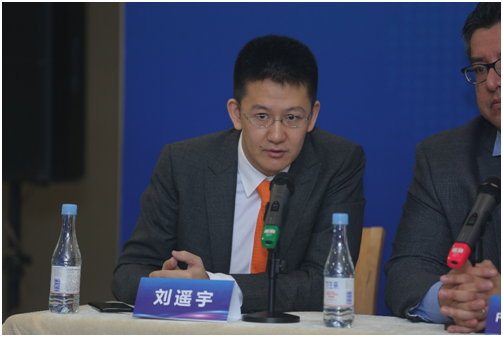ã€Global Network Science and Technology Report】 On July 16th, the Sino-U.S. medical education exchange media meeting, the Brigham & Women's Hospital of Harvard Medical School and the Xinan medical exchange meeting were held in Beijing. Xinan Medical Chairman Zhang Jie, CEO Gu Guangyao, COO Liu Yaoyu, Associate Dean of Harvard Medical School, Dr. Fidencio Saldana, Dr. Charles Pozner, Director of Medical Simulation Center, Brigham and Women's Hospital, Harvard Medical School, and other leaders, and medical media health My colleagues attended the meeting.

With the promulgation of the "Guiding Opinions on Establishing a Standardized Training System for Resident Physicians" by the National Health and Family Planning Commission, the establishment of a standardized training system for inpatient clinicians, deepening reforms in medical and health care systems, and medical education reforms has been officially put on the agenda. At the same time, the Health and Health Conference held in 2016 has for the first time promoted "Healthy China" as a national strategy and issued the "Outline of the Healthy China 2030 Plan." The outline includes “To popularize healthy life, to optimize health services, to improve health protection, to build a healthy environment, and to develop a health industry.†The medical industry is an integral part of the “health industry,†and the development of the medical industry is The implementation of the "Healthy China" strategy and the development of the great health industry all have a crucial and positive role.

The conference also attracted the participation of many outstanding medical experts and scholars from home and abroad, and established a highly efficient and interactive platform for communication between Chinese and American medical experts. Through this international exchange, the latest and most cutting-edge medical education technology achievements of the Chinese and American medical communities are shared, and the bridge between the Xin'an medical and medical education section and the general practitioners of the Brigham and Women's Hospital of Harvard Medical School is established. It has played a positive and important role in the continuous development of China's medical education.


At the exchange meeting, Xinan Medical and Brigham and Women's Hospital of Harvard Medical School will collide with new sparks in the field of medical education at this meeting. Dr. Fidencio Saldana, Associate Dean of Harvard Medical School and Dr. Charles Pozner, Director of the Center for Medical Simulation at Brigham and Women's Hospital, Harvard Medical School, delivered speeches. The two sides conducted friendly and friendly exchanges on the relevant work of resident doctors and general practitioners in standardization training, and proposed that “standardized physician training will not only help improve the overall medical standard in China, but also enhance the basic clinical skills of physicians, thereby reducing the incidence of medical accidents. At the same time, clinical training can be conducted through more humane bionic dummy and simulation scenarios to achieve convergence with the international mainstream medical education and training model to better meet the growing demand of the people for medical services."

In the subsequent on-site interviews and question sessions, the two sides jointly explored the coordinated development of Chinese and American medical education, worked hard to cultivate qualified medical personnel and satisfied the people's health needs, and worked hand in hand to provide better conditions and environment for the training of medical personnel. On the spot, colleagues in the medical and health field attended the conference and also increased their enthusiasm for medical education.
If the National Health and Family Planning Commission promulgates the "Guidance Opinions on Establishing a Standardized Training System for Resident Physicians", which marks the importance of national level medical continuing education and the determination to urgently catch up with the advanced international medical standards, this exchange will be the focus of the peace and medical care. Brigham and Women's Hospital, Harvard Medical School, USA, through the sharing of the latest and most cutting-edge medical educational technology achievements between the Chinese and American medical communities, achieves the purpose of drawing on international experience, promoting the development of medical continuing education, and bringing about an important role in the modernization of China's medical industry. Promote the role.
Glass tube liquid level gauge is a direct reading liquid level measuring instrument, which is suitable for the on-site detection of liquid position in general liquid storage equipment in the process of industrial production. It has simple structure and accurate measurement. It is a traditional on-site liquid level measuring tool. Generally used for direct detection. A needle valve is installed at both ends of the liquid level gauge. When the glass tube is broken due to an accident, the needle valve will automatically close under the pressure of the container to prevent the medium in the container from flowing out.
Marine Glass Tube Level Gauge,Marine Dial Level Gauge,Magnetic Float Level Gauge,Ss Magnetic Float Liquid Level Gauge
Taizhou Jiabo Instrument Technology Co., Ltd. , https://www.jbcbyq.com